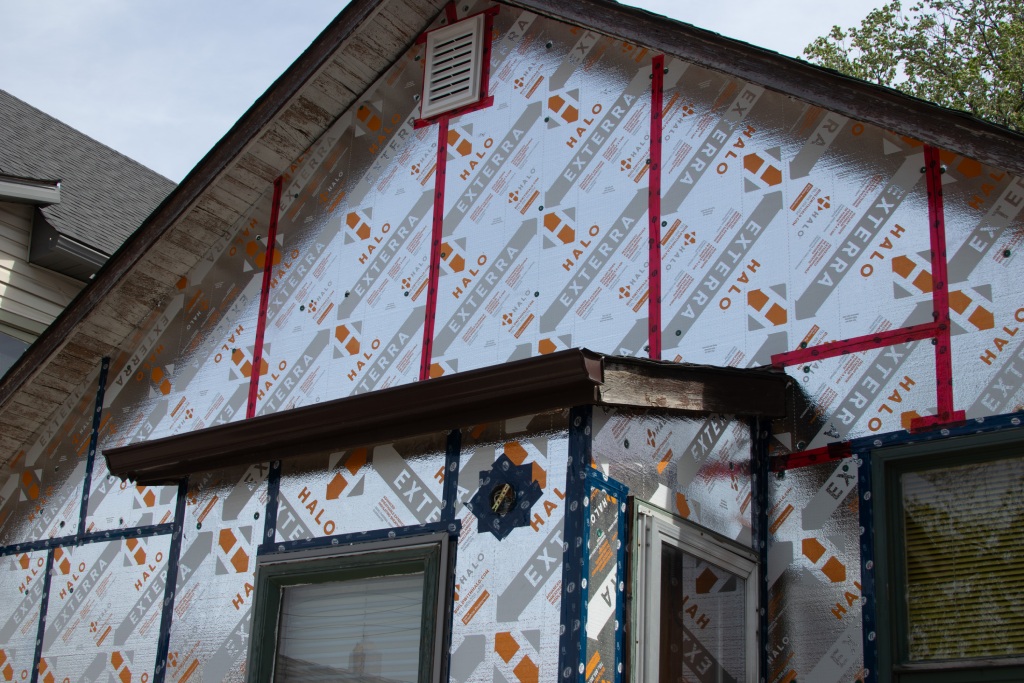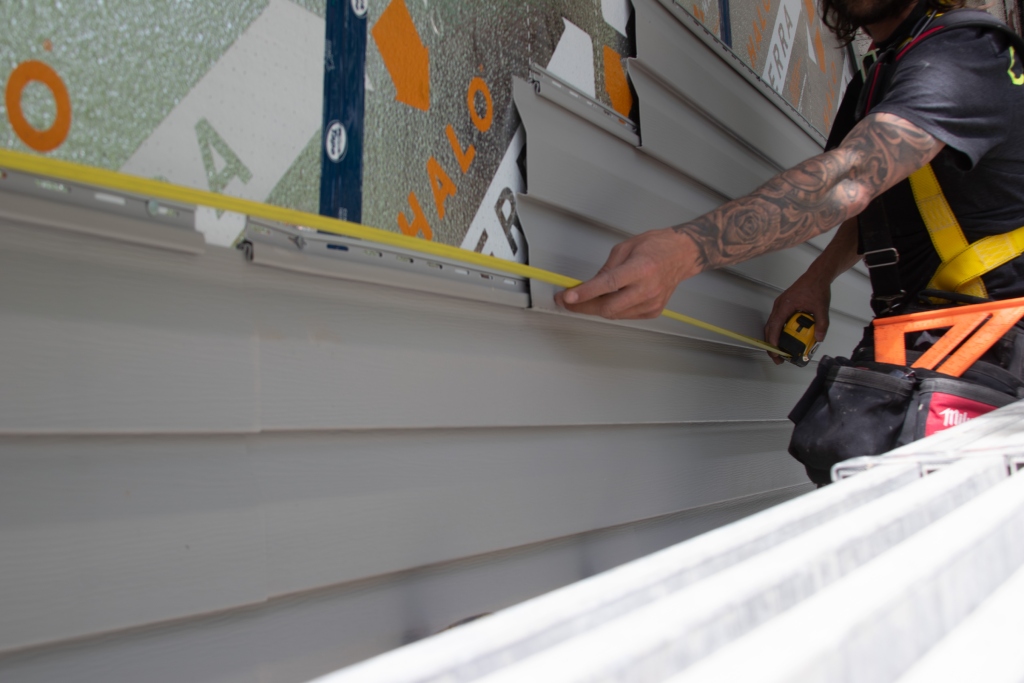
Still thinking about what summer project to tackle? We have a project we think is worth mentioning. In modern construction, exterior insulation and rainscreens are vital additions to any high‑performance wall system. By wrapping the building envelope in insulation from the outside, you reduce heat loss, eliminate thermal bridging, and improve overall energy efficiency. When combined with a rainscreen wall system—complete with air gaps, furring strips, and proper cladding attachment systems—these measures prolong cladding lifespan, prevent moisture damage, and contribute to healthier indoor environments.
Winnipeg’s climate can put serious stress on exterior walls. With extreme cold, frequent freeze‑thaw cycles, snow, sleet, and heavy rain, local exterior walls face recurring challenges. A well‑designed exterior insulation and rainscreen insulation systems provides durable protection, drainage, and ventilation layers for drying. It allows walls to dry properly, sheds moisture safely, and preserves exterior cladding—whether fiber cement, stucco, wood, or other materials—through long, harsh winters and warm humid summers. The combination of exterior insulation and rain screens isn’t just a recommendation—it’s a crucial part of maintaining a healthier, more energy-efficient home.
Understanding Exterior Insulation
Definition
So, what exactly is exterior insulation? Exterior insulation refers to installing rigid insulation layers—such as rigid foam boards or rockwool Comfortboard—on the outside of the framed stud cavity, before applying the final exterior cladding. Unlike traditional insulation (installed within the framing), this strategy creates a continuous thermal boundary or blanket, drastically reducing heat transfer across studs (thermal bridging) and boosting the wall’s total R‑value. Think of it as wrapping your entire house in a cozy, seamless blanket.
Benefits
1. Thermal Bridging Reduction
In a typical stud‑framed wall, the framing members create pathways for heat to bypass the insulation. By wrapping the exterior, you interrupt these cold/hot spots, improving room‑to‑room insulation R-value and seasonal energy efficiency.
2. Continuous Insulation Layer
Outdoor rigid or mineral wool insulation forms an unbroken thermal shield around the home. No gaps, seams or compression—just continuous protection with air, moisture, and water vapor managed—with superior insulation performance.
3. Improved Comfort
By minimizing drafts and temperature swings, your living space becomes a more comfortable and enjoyable place year-round. Even when Winnipeg plunges to −30 °C, your inside temperature stays consistent, helping reduce energy demand—and that means lower heating bills.
4. Common Materials Used
- Rigid foam boards (like EPS and XPS) offers high R‑value per inch, is easy to install, and provides excellent thermal and moisture resistance.
- Mineral wool (often known by the brand rockwool Comfortboard) is not only a great insulator but is also fire-resistant, water-repellent, and offers superior sound-dampening qualities.
- Spray foam can seal gaps and provide R‑value close to the framing plane, expanding to fill every crack and crevice, which creating a superb air and vapor barrier.
Application in Winnipeg Homes
Local homes range from post‑war stucco and brick veneer to modern fiber cement houses. Insofast‑type insulation attachments make retrofits easier by allowing installers to fix insulation and furring strips to existing stud or masonry walls. It’s a flexible solution that integrates smoothly into typical Winnipeg renovation scopes.
The Importance of Rainscreens
Now, let’s talk about the other half of this dynamic duo: the rainscreen wall. A rainscreen insulation system should be seen as a support system for the building envelope, designed primarily to manage moisture rather than act as a direct barrier against water penetration. To clarify, a rainscreen is not a type of siding, but a wall system that creates a small, ventilated air gap between your siding (cladding) and the rest of your wall assembly. This is typically achieved by attaching vertical furring strips to the exterior wall insulation before the final cladding is installed.
Definition
A rainscreen system is an exterior wall assembly that includes:
- A drainage plane or weather‑resistant barrier
- A ventilated air gap space behind the cladding
- Proper flashing, furring strips, and attachment systems to secure the cladding
Functionality
- Moisture Management: Rain, snow and wind‑driven moisture are constantly battling the exterior. A rainscreen prevents water from penetrating the building envelope that supports evaporation and channels moisture downward to safe drainage points—creating a “sacrificial” layer that protects the inner structure.
- Ventilation: The air gap created by 1″x4″ furring strips allows continuous airflow, helping any intruding moisture to evaporate quickly. This not only prevents mould but also eliminates rot and premature decay.
Benefits
Extended Siding Lifespan: When exterior cladding can dry, it lasts longer—whether it’s wood, fiber cement, or stucco. Paint and sealants maintain adhesion, and wood expands/contracts less when moisture is controlled, reducing the need for premature repairs or replacement.
Enhanced Durability: Rainscreens take the brunt of weather exposure, protecting insulation and structural framing from damage. In climates prone to rain and freezing, this extra protection is invaluable.
Relevance to Winnipeg’s Climate
In places like Winnipeg, where snow, ice, and rain coexist throughout the season, a rainscreen is no luxury—it’s essential link to a healthy home. Sources like TD Robinson and Metal Construction News emphasize how critical drainage and air movement are to prevent moisture locking that could otherwise degrade insulation systems and promote frost‑related damage.
Integrating Exterior Insulation with Rainscreens
Synergy Between Systems
Combining exterior insulation with a rainscreen wall delivers a best‑in‑class wall assembly. The exterior insulation provides the thermal control, while the rainscreen manages moisture, resulting in a wall system that is warm, dry, and incredibly durable:
- The insulation improves R‑value, reducing heating demand
- The rainscreen manages moisture and protects internal layers
- Together, they create a durable, efficient, and healthy wall system
Installation Considerations
Strapping and Air Gaps
- Using vertical furring strips (often 1″×4″) not only creates an air gap but also provides a solid surface to attach cladding, offering functional drainage and ventilation channels.
Material Compatibility
- Rigid foam and wood cladding attachment systems must be evaluated together for screws, spacing, and compressive strength. Proper coordination ensures both an energy‑efficient and structurally secure assembly.
Best Practices
Sequencing
- Install weather barrier and flashing at base
- Apply exterior insulation boards
- Install vertical furring strips
- Attach rainscreen cladding (e.g., fiber cement, stucco)
- Complete flashing at windows, top plates, and transitions
Flashing and Sealing
All penetrations—windows, vents, utility wraps—must be properly sealed. Flashing directs any infiltrating water outwards, while sealants ensure a continuous moisture barrier.
Expert Above All Insulation Advice
Exterior Insulation and rain screens are best practice in our opinion, when completing an exterior project. One of the best ways to improve efficiency of a wall assembly is to add insulation to the exterior of the home, because this insulation is continuous and provides a thermal break over the thermal bridging wood frame construction. The typical 1”x4” vertical strapping used provides a ¾” airspace which allows the wall assembly to ventilate. This provides longevity for the wall assembly, insulation, substructure, and siding. It will add years to the life of your exterior, and most visibly years to the paint job of your siding. This will increase the cost of the project, but over the long term will reduce the costs associated with long term home ownership.
Pro Tip: Spend money on the things that are unseen to ensure the things that are seen will stay beautiful for years to come.
Long‑Term Benefits for Homeowners
Investing in an integrated exterior insulation and rainscreen system pays dividends for years to come:
- Energy Efficiency: The most immediate benefit is a reduction in your heating and cooling costs. A well-insulated and protected building envelope means your furnace and air conditioner don’t have to work as hard.
- Maintenance Savings: With a longer-lasting siding and a wall system that’s protected from moisture damage, you’ll spend less on repairs and repainting over the years.
- Increased Property Value: A home with superior energy performance and a durable exterior is a more attractive and valuable asset. These upgrades can even contribute to LEED credits for green building.
- Comfort and Health: Enjoy more consistent indoor temperatures and healthier indoor air quality, thanks to the reduction in mold and mildew growth.
Above All Insulation’s Expertise
At Above All Insulation, we understand the unique challenges of Winnipeg’s climate. We don’t believe in one-size-fits-all solutions.
- Customized Solutions: Above All’s team visits each home to evaluate existing framing, insulation levels, stud cavities, air, and moisture pathways—then designs a system tailored for your exterior walls.
- Quality Assurance: Only high‑quality products—like rockwool Comfortboard, foam boards, and weather‑resistant membranes—are used, ensuring attention to details like flashing, nailing patterns, that meets local code and recommended requirements.
- Local Experience: With years of working in Winnipeg, Above All Insulation understands how to build to withstand extreme cold, moisture load, and freeze‑thaw cycles—helping clients earn rebates, potential LEED credits, and long‑lasting comfort.
Conclusion: A Smarter Way to Protect Your Home
In Winnipeg’s harsh climate, integrating exterior insulation and rainscreens is one of the smartest ways to boost your home’s energy efficiency, comfort, and durability. By reducing thermal bridging and creating a continuous insulation layer, exterior insulation helps lower energy bills and maintain stable indoor temperatures. At the same time, a well-ventilated rainscreen wall manages moisture, encourages drying, and extends the life of your cladding, whether it’s stucco, fiber cement, or wood.
The connection between exterior insulation and rainscreen insulation systems creates a powerful system that works together to protect your home; they link thermal performance with moisture control and connect every layer of the wall assembly for lasting durability. Together, these systems form a high-performance wall assembly that protects your building envelope from rain, snow, and freeze-thaw damage. With proper flashing, furring strips, and quality materials, your home stays drier, warmer, and healthier. Above All Insulation offers expert installation tailored to Winnipeg homes—helping you improve performance, protect your investment, and potentially qualify for Efficiency Manitoba rebates.
Ready to elevate your home’s performance and resilience? Contact us today to get a free quote, schedule a comprehensive assessment or to learn more about your upgrade options. We’ll assess your wall system, including flashing, furring strips, and framing, to help reduce energy bills, manage moisture, and boost year-round comfort. Let’s work together to make your home the best it can be.
Frequently Asked Questions
Q: How do I know if my home needs exterior insulation and a rainscreen?
A: Look for signs like high heating costs, cold interior walls, drafts, uneven temperatures, or visible cladding damage such as cracked stucco or faded siding.
Q: Can these systems be added to existing homes?
A: Yes! Both systems are well‑suited to retrofits during renovations or siding replacements. With the right wall assembly and cladding attachment systems, they integrate smoothly with your existing studs and framing.
Q: Are there rebates available for installing these systems?
A: Absolutely. Programs like Efficiency Manitoba offer rebates for improving energy efficiency—especially when you enhance exterior insulation and upgrade your exterior walls. Consult Above All for current rebate options and assistance in securing them.
